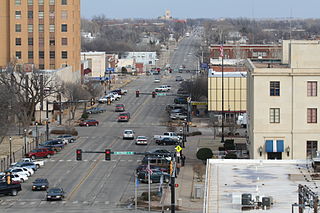
Bonnie Elizabeth Parker and Clyde Chestnut "Champion" Barrow were American outlaws who traveled the Central United States with their gang during the Great Depression. The couple were known for their bank robberies and multiple murders, although they preferred to rob small stores or rural gas stations. Their exploits captured the attention of the American press and its readership during what is occasionally referred to as the "public enemy era" between 1931 and 1934. They were ambushed by police and shot dead in Bienville Parish, Louisiana. They are believed to have murdered at least nine police officers and four civilians.

Enid is the ninth-largest city in the U.S. state of Oklahoma. It is the county seat of Garfield County. As of the 2020 census, the population was 51,308. Enid was founded during the opening of the Cherokee Outlet in the Land Run of 1893, and is named after Enid, a character in Alfred, Lord Tennyson's Idylls of the King. In 1991, the Oklahoma state legislature designated Enid the "purple martin capital of Oklahoma." Enid holds the nickname of "Queen Wheat City" and "Wheat Capital" of Oklahoma and the United States for its immense grain storage capacity, and has the third-largest grain storage capacity in the world.
Base Realignment and Closure (BRAC) was a process by a United States federal government commission to increase the efficiency of the United States Department of Defense by coordinating the realignment and closure of military installations following the end of the Cold War. Over 350 installations have been closed in five BRAC rounds: 1988, 1991, 1993, 1995, and 2005. These five BRAC rounds constitute a combined savings of $12 billion annually.
Raymond Elzie Hamilton was a member of the notorious Barrow Gang during the early 1930s. By the time he was 20 years old, he had accumulated a prison sentence of 362 years.

Enid High School (EHS) is a public tertiary school in Enid, Oklahoma, U.S., operated by the Enid Public Schools school district. With a student body of about 2035 in grades 9–12, Enid High School has a matriculation rate of about 65 percent.

Heslar Naval Armory was constructed in 1936 in Indianapolis, Indiana, United States, on the shore of White River as a Works Progress Administration construction project. It was designed by architect Ben H. Bacon and reflects an Art Moderne style. Heslar Naval Armory was the home of Naval Operations Support Center Indianapolis, Marine Corps Reserve Center Indianapolis, and Naval Recruiting Station Indianapolis, as well as the United States Naval Sea Cadet Corps Cruiser Indianapolis (CA-35) Division and the Central Indiana Young Marines of the Marine Corps League. In October 2008 the Indiana Wing Civil Air Patrol, state branch of the US Air Force Auxiliary, moved its headquarters functions and staff to the Armory.
Enid Public Schools is a public school district located in Enid, Oklahoma, USA. The school district had an enrollment of 7,540 students in September 2012.

This is a list of the National Register of Historic Places listings in Garfield County, Oklahoma.

The Broadway Tower, located in the Enid Downtown Historic District in Enid, Oklahoma, was constructed in 1931 by McMillen and Shelton Construction Company. The Broadway Development Company hired George Ernst von Blumenauer of Enid, and the Oklahoma City firm Layton, Hicks, and Forsythe to design the building, in the Art Deco style.

The Bonnie and Clyde Garage Apartment is located at 3347+1⁄2 Oak Ridge Drive in Joplin, Newton County, Missouri. Its front door opens onto 34th Street. It was built about 1927, and is a two-story building on a poured concrete foundation. It has a gently pitched hipped roof and exposed rafter ends in the American Craftsman style.

The Garfield County Courthouse is a historic courthouse building located in Enid, Oklahoma. It is on the National Register of Historic Places both individually and as a part of the Enid Downtown Historic District.

The Cherokee Strip Regional Heritage Center (CSRHC) is a museum in Enid, Oklahoma, that focuses on the history of the Cherokee Outlet and the Land Run of September 16, 1893. Previously named the Museum of the Cherokee Strip, the museum has undergone renovations expanding the museum space to 24,000 square feet. The Cherokee Strip Regional Heritage Center is home to permanent and temporary exhibit galleries, a research center, and the Humphrey Heritage Village.

The Public Library of Enid and Garfield County, is a public library located in Enid, Oklahoma, the county seat of Garfield County, Oklahoma.
Bryan W. Nolen was an Oklahoma City, Oklahoma architect who served as a Major in the Oklahoma National Guard. He designed numerous armories built under the Works Progress Administration. He is credited with more than 20 buildings that are preserved and listed on the National Register of Historic Places.

Fort Homer W. Hesterly is a historic building at 522 North Howard Avenue in the West Tampa section of Tampa, Florida. The building and adjacent support structures were originally constructed as a U.S. military facility to house units of both the Florida Army National Guard and the U.S. Army Reserve. The armory was built in the 1930s under Franklin Delano Roosevelt's New Deal and dedicated the day after the Pearl Harbor attack. The National Guard used the armory until 2005.

The Stride Bank Center is an arena in downtown Enid, Oklahoma.

The Duluth Armory is a former armory and event venue in the East Hillside neighborhood of Duluth, Minnesota, United States. It was built in 1915 for the National Guard and naval militia, and expanded in 1941. From the beginning the National Guard also rented out the drill hall as an event venue, as it provided a larger and more flexible space than any other local venue until the construction of the Duluth Arena-Auditorium in 1966.

The Pawnee Armory in Pawnee County, Oklahoma, United States, is a single story rectangular building measuring 149 ft (45 m) x 237 ft (72 m). It was built of native stone by the Works Progress Administration. According to the plaque on the building it was completed in 1936, though the application form for the National Historic Places Registration form indicates it was finished in 1937. It originally housed the Oklahoma National Guard. It was added to the National Register of Historic Places in 1994.

The Helena National Guard Armory is a historic armory building at 511 Miller Street in Helena, Arkansas. It is a single-story brick-and-masonry structure, built in 1936–37 using Works Progress Administration funds to house the Battery G of the 206th Coastal Artillery. The building's main facade as strong Art Deco styling, with its predominantly brick facing topped by concrete courses, and a strong vertical emphasis achieved by two towers and four pilasters on a pointed-arch roofline. The building housed a variety of military companies between its opening and its closure in 1978.






















